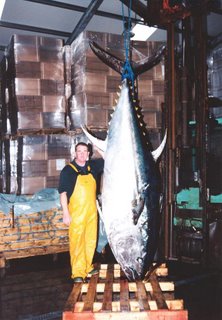Tuna Enhancement Program
Since my posting of yesterday, Tuna fish has filled my thoughts in regards to the price per pound differential between the Tuna and our own wild Alaskan Salmon. The American consumer eats more canned tuna than any other specie of fish, including our own canned salmon. In my own household, we eat more tuna than salmon even though we live on a world class salmon river.
Over the past few years, I have seen many of our commercial fishermen give up their traditional fisheries that they have passed through the family over the decades. The commercial fleet of salmon fishermen get smaller as each year passes. I have witnessed the price of cod bringing higher prices to the fishermen than the specie that was our mainstay, the salmon fisheries.
Each year, the State of Alaska with the assistance of federal programs stock or enhance many of our fisheries, even though our native runs are still strong. For instance, in "Smoky Bay" there are three enhancement sites, Homer Spit, Halibut Cove and Seldovia. The commercial enhancement site at Tutka Bay Lagoon for Pink Salmon which has funded by the Lower Cook Inlet Seiners Association has been shut down due to the decline in the price of Pink Salmon (12 cents per pound).
On this snowy day, I have spent the day researching this subject and have come to the conclusion that as long as our native run of salmon remain healthy, perhaps we should consider introducing a new specie that could be utilized as both a great sport fish and a very valuable commercial fish. Within a few short years, we could make the "Little Hamlet By the Sea" the tuna capital of at least Alaska. It would be my proposal, to the Department of Fish and Game, that we curtail any further stocking programs of salmon into the enhanced fisheries of Kachemak Bay and immediately commence a Tuna Enhancement project.
The "eggs" of the female tuna takes only a few days to hatch once they have been fertilized and free float on the water currents until they hatch. The waters of the lagoon on the Homer Spit and Halibut Cove Lagoon could be utilized as a hatching and rearing area because of the exchange of water and feed every six hours. They could be raised to fishable size, which is one year and then released into Kachemak Bay. The tuna does not die after spawning like our salmon. The Tutka Bay Lagoon could be re-opened and utilized as a commercial rearing area for tuna for the commercial fishermen. It would be interesting to see how many of the "spit snaggers" could hold onto a 200 pound tuna!
When most people think of Tuna, they think of tropical breezes, bikini clad women running around on boats, and fishing in our boxer shorts. Although, these are all great thoughts to have when you look out your window and see three feet of snow in your yard, it is possible to have Tuna in the colder waters of Alaska.
Several species of Tuna will range into the northern Pacific waters. Typical, these waters will be in the southeast and Gulf Of Alaska, however, a good number of Bluefin Tuna have been taken in the Shelikof Straits. Tuna fishing is quite productive in the northern Atlantic, the Grand Banks is world known for their Tuna fishing and has similar water conditions as Alaska.
 In my research, I discovered that Tuna fishing has become a very popular sport fishery in Ireland, as indicated by the photo. Tuna first started showing in this area in the 1950's and since that time the population has continued to increase that it is now supporting both a commercial and sport fishery. The water temperature changes in Ireland are very similar to those we see in Alaska.
In my research, I discovered that Tuna fishing has become a very popular sport fishery in Ireland, as indicated by the photo. Tuna first started showing in this area in the 1950's and since that time the population has continued to increase that it is now supporting both a commercial and sport fishery. The water temperature changes in Ireland are very similar to those we see in Alaska.
I will continue my research, although I may need to travel to Ireland, Canada, Nova Scotia, Mexico, Hawaii, and Australia to gather data and spend a little time fishing. This will be a very expensive research expedition so any personal funding that you could provide would be greatly appreciated. While I am on my "research expeditions" it may also help in the establishment of this program if everyone would write to Govenorness Palin as well as the good folks at the Department of Fish and Game encouraging them to assist in the implementation of this project. If we work together on this, we can be getting in some good Tuna fishing within the next five years and our commercial fishermen will be bringing in fish that will fetch $50.00 plus dollars per pound instead of less than a dollar a pound for their salmon. The future fishery of Alaska, "Wild Alaskan Tuna"!

